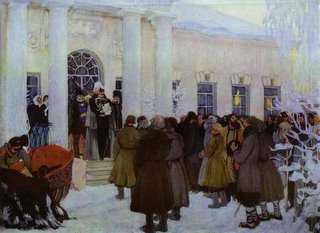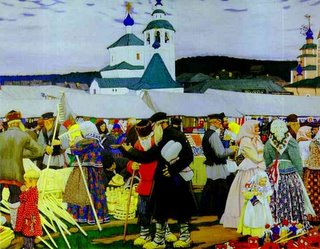. . . at the New York Public Library.
Here's also something nice by Max Ernst.
Sunday, May 28, 2006
Monday, May 22, 2006
22 May 1859
Today is Arthur Conan Doyle's birthday.
It might also, therefore, be considered the birthday of the inimitable Sherlock Holmes himself.
I first read him when I saw a book at the library whose spine said, The Essential Boy's Sherlock Holmes (or something like that).
I read the title and said, "Aha! You sexists, I'll show YOU!" So I read the whole thing. And then I read the rest of the books in the Teen Section. Then I ventured into ADULT FICTION, stood on a chair, and day by week by month read all of the big dusty books off of that top shelf.
The Sign of the Four is one of my favorites. Ahhh, scratch that--they're all really good.
These people like him just as much as I do.
It might also, therefore, be considered the birthday of the inimitable Sherlock Holmes himself.
I first read him when I saw a book at the library whose spine said, The Essential Boy's Sherlock Holmes (or something like that).
I read the title and said, "Aha! You sexists, I'll show YOU!" So I read the whole thing. And then I read the rest of the books in the Teen Section. Then I ventured into ADULT FICTION, stood on a chair, and day by week by month read all of the big dusty books off of that top shelf.
The Sign of the Four is one of my favorites. Ahhh, scratch that--they're all really good.
These people like him just as much as I do.
Saturday, May 20, 2006
Hello, Boris.

The Reading of the Manifest.

The Fair.
Boris Kustodiev (Kustodiyev) painted these things.
He was part of the Mir Iskusstva (look here too).
This is a page of more images of his work.
Monday, May 15, 2006
Poetreeeeeee
I like these.
By Michael Drayton (1563-1631).
By Robert Browning (1812-1889). I was actually only given a cutting of this one at first, but I like the whole thing (even if I don't understand it).
By Elizabeth Bishop (1911-1979). Trivia! Some of her unpublished poems were recently collected and published by Alice Quinn (look!). It's caused something of an uproar--if a poet had the chance to publish some of her work, and didn't, should people root through her things after she's dead and shove them in the public's face? The Denver Post had a nifty article about the problem. And here's something from The Atlantic Monthly (sigh) published in January.
By Michael Drayton (1563-1631).
By Robert Browning (1812-1889). I was actually only given a cutting of this one at first, but I like the whole thing (even if I don't understand it).
By Elizabeth Bishop (1911-1979). Trivia! Some of her unpublished poems were recently collected and published by Alice Quinn (look!). It's caused something of an uproar--if a poet had the chance to publish some of her work, and didn't, should people root through her things after she's dead and shove them in the public's face? The Denver Post had a nifty article about the problem. And here's something from The Atlantic Monthly (sigh) published in January.
Heaven help me.
This is what people actually do at the school I'm going to. And I hope that what he's wearing isn't an informal uniform.
Saturday, May 13, 2006
I learned something new!
(Remember that bhajan that was called "Aiso Ko Udaar Jag Maahi"? Turns out that that line, which is the sthai, or primary theme, means "The Lord is all merciful.")
The story of Mira Bai feels similar to the stories of the Catholic saints--you know, we can visit Saint Catherine's house, but we don't know if she really loved God when she was three, or what exactly she was like. Historical facts get all mixed up with oral tradition, and literary tradition, and the beautiful ideas painters have long after the people are dead.
But we do know some things almost certainly--Mira Bai (Meera Bai) was a nobel woman in Rajasthan, an area in India. She was married to the king-to-be at thirteen, but the family didn't take to her and made trouble. And here's the good part, the not-necessarily-factual part: she said she couldn't really be a wife to the king, because she had already dedicated her whole heart to Lord Krishna. Her husband died, and she did not commit satti (also sati, suttee) but instead wandered Rajasthan, preaching and writing poetry and music. She is credited with at least 200 bhajans, though some attribute more than 1300 to her. Her writing is called a whole bunch of things--"mystical love poetry" or "love poetry" seem to be repeated the most. In any case, she had an overwhelming love for Krishna, to whom she devoted her life.
To learn more (IT'S SO INTERESTING!):
Here is a basic summary.
Here is a very comprehensive website, with good links to other respectable sites, where you can read her writing or listen to some of the bhajans.
Here is more, and here, and here is Wikipedia's take.
And here is an interesting one by a believer (like reading about St Catherine from a Catholic traditionalist).
The story of Mira Bai feels similar to the stories of the Catholic saints--you know, we can visit Saint Catherine's house, but we don't know if she really loved God when she was three, or what exactly she was like. Historical facts get all mixed up with oral tradition, and literary tradition, and the beautiful ideas painters have long after the people are dead.
But we do know some things almost certainly--Mira Bai (Meera Bai) was a nobel woman in Rajasthan, an area in India. She was married to the king-to-be at thirteen, but the family didn't take to her and made trouble. And here's the good part, the not-necessarily-factual part: she said she couldn't really be a wife to the king, because she had already dedicated her whole heart to Lord Krishna. Her husband died, and she did not commit satti (also sati, suttee) but instead wandered Rajasthan, preaching and writing poetry and music. She is credited with at least 200 bhajans, though some attribute more than 1300 to her. Her writing is called a whole bunch of things--"mystical love poetry" or "love poetry" seem to be repeated the most. In any case, she had an overwhelming love for Krishna, to whom she devoted her life.
To learn more (IT'S SO INTERESTING!):
Here is a basic summary.
Here is a very comprehensive website, with good links to other respectable sites, where you can read her writing or listen to some of the bhajans.
Here is more, and here, and here is Wikipedia's take.
And here is an interesting one by a believer (like reading about St Catherine from a Catholic traditionalist).
Monday, May 08, 2006
Subscribe to:
Comments (Atom)



